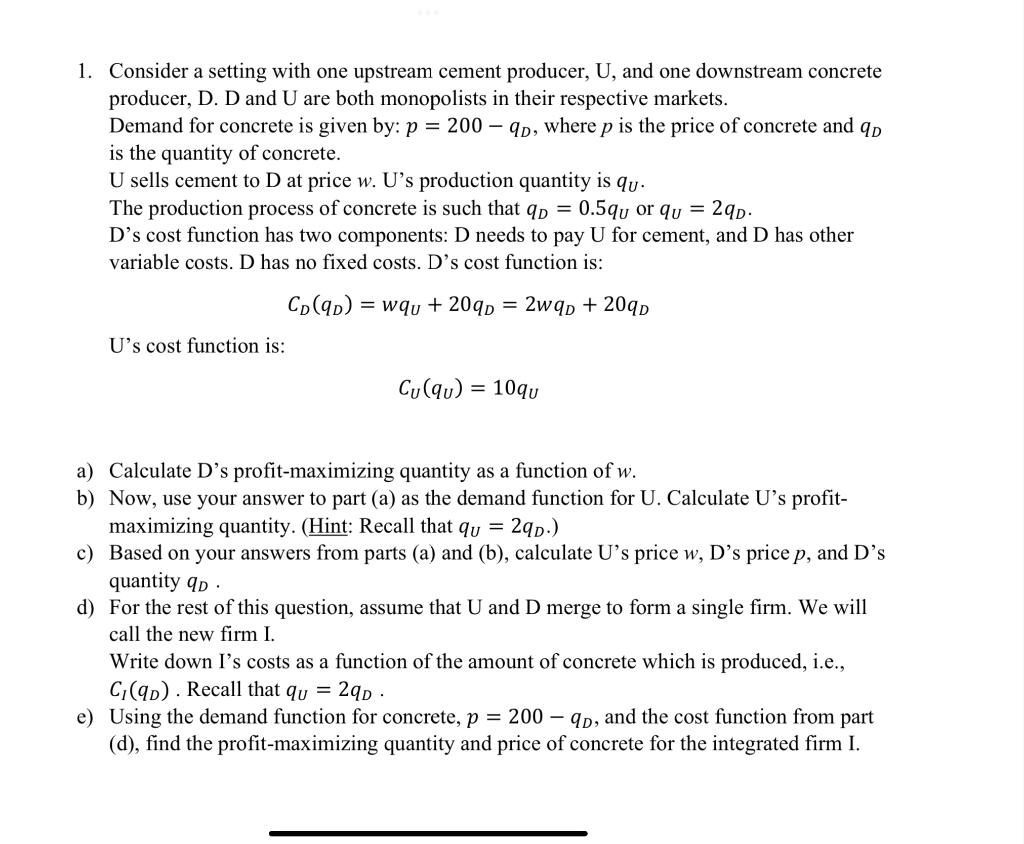
1. Consider a setting with one upstream cement producer, U, and one downstream concrete producer, D. D and U are both monopolists in their respective markets. Demand for concrete is given by: p=200qD, where p is the price of concrete and qD is the quantity of concrete. U sells cement to D at price w. U's production quantity is qU. The production process of concrete is such that qD=0.5qU or qU=2qD. D's cost function has two components: D needs to pay U for cement, and D has other variable costs. D has no fixed costs. D's cost function is: CD(qD)=wqU+20qD=2wqD+20qD U's cost function is: CU(qU)=10qU a) Calculate D's profit-maximizing quantity as a function of w. b) Now, use your answer to part (a) as the demand function for U. Calculate U's profitmaximizing quantity. (Hint: Recall that qU=2qD.) c) Based on your answers from parts (a) and (b), calculate U's price w, D's price p, and D's quantity qD. d) For the rest of this question, assume that U and D merge to form a single firm. We will call the new firm I. Write down I's costs as a function of the amount of concrete which is produced, i.e., CI(qD). Recall that qU=2qD. e) Using the demand function for concrete, p=200qD, and the cost function from part (d), find the profit-maximizing quantity and price of concrete for the integrated firm I. 1. Consider a setting with one upstream cement producer, U, and one downstream concrete producer, D. D and U are both monopolists in their respective markets. Demand for concrete is given by: p=200qD, where p is the price of concrete and qD is the quantity of concrete. U sells cement to D at price w. U's production quantity is qU. The production process of concrete is such that qD=0.5qU or qU=2qD. D's cost function has two components: D needs to pay U for cement, and D has other variable costs. D has no fixed costs. D's cost function is: CD(qD)=wqU+20qD=2wqD+20qD U's cost function is: CU(qU)=10qU a) Calculate D's profit-maximizing quantity as a function of w. b) Now, use your answer to part (a) as the demand function for U. Calculate U's profitmaximizing quantity. (Hint: Recall that qU=2qD.) c) Based on your answers from parts (a) and (b), calculate U's price w, D's price p, and D's quantity qD. d) For the rest of this question, assume that U and D merge to form a single firm. We will call the new firm I. Write down I's costs as a function of the amount of concrete which is produced, i.e., CI(qD). Recall that qU=2qD. e) Using the demand function for concrete, p=200qD, and the cost function from part (d), find the profit-maximizing quantity and price of concrete for the integrated firm







